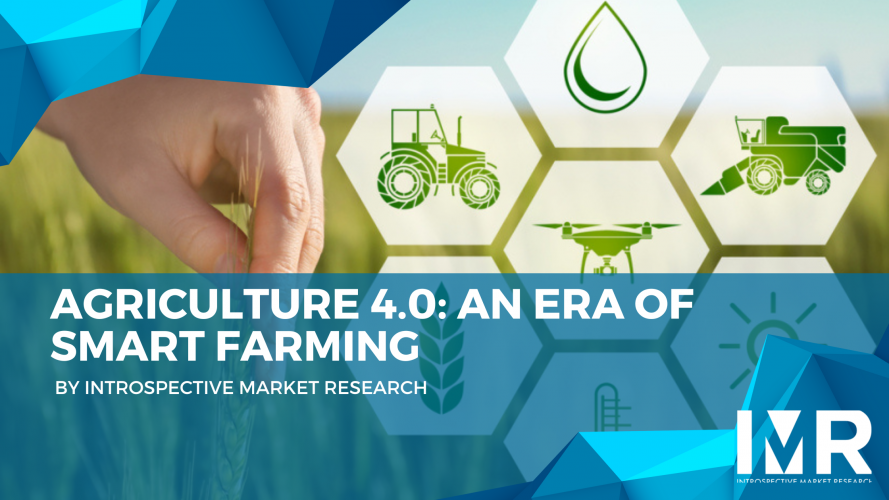
The technical term Agriculture 4.0 derived as an analogy to the term Industry 4.0, which was created by the Ministry of Education and Research of the German government in a final report of the Working Group (WG) officially instituted to develop guidelines for the German industry in the context of combining it into a "smart, networked world." In addition, Agriculture 4.0 is referred to as the systems that employ drones, robotics, Internet of Things (IoT), artificial intelligence (AI), vertical farms, and solar energy. Through the integration of digital technology into farming practices, companies are enabling rising yields, overcoming costs, experiencing less crop damage, and reducing water, fuel, and fertilizer usage. For the consumer, this equals cheaper and better-quality food. Nevertheless, there are some complex challenges in the crop production industry, along with decreased production profit margins for farmers. To grow the food and to supply the world's needs, crop production systems require the new and latest solutions to produce more in an environmentally, economically, and socially viable way. Therefore, at the time of the interpretative framework, intentions, and the scope considering over the agriculture 4.0 are thought-provoking and exciting at the first instance, its successful execution is the key challenge across the globe. The recent and new global trends and positively affect food security, poverty, and the overall sustainability of food and agricultural systems.
Promoting The Agri-Food Supply Chain
As governments in different economies have been enacting laws to improve the supervision of agricultural products, there has been an increasing need for agri-food supply chain traceability. The food supply chain is attributable through the implication of perishable products. Consequently, there is a stringent requirement to control specified environmental conditions from farms to stores/tables. The IoT technology operates as a beneficial tool in the food supply chain owing to its end-to-end visibility. Sensors are utilized to continue to maintain track of temperature, humidity, and any other conditions that cause harm to the perishability of the products. If any factor changes beyond the set threshold, shippers will get a warning. Smart agriculture gadgets powered by IoT can offer added value to the agricultural domain by supporting farmers to reduce the challenges faced by the growing demand for food security and the lack of labor force.
Technologies Used In Agriculture 4.0
The application of the latest technologies in agriculture can be employed in various ways. therefore, this latest technology to receive the data of interest, which enables analysis to be carried out for greater optimization in the use of available resources. Additionally, it is also possible to use new technologies to gain greater automation and efficiency when operating tasks in crops.
Some of the Major Important Technologies And Techniques Used In Agriculture 4.0 Are Explained Below
Drones:
The application of drones (unmanned aircraft) is starting to have emerged in the Agritech sector in different ways. One of their most common applications is the capture of images of the crops. These images are later analyzed with SW programs that offer information regarding how the crops are evolving. This way, the farmer knows, for example, which areas require to be watered more thoroughly (the analysis here is usually based on the radiation that the vegetables release or reflect in certain bands of the EM spectrum), where there are more weeds to remove, or if there is the presence of any plague. Companies such as Aerial Insights, from Spain, provide this kind of analysis over photographs as part of their business. Less commonly but also possible, companies are utilizing drones as remote fertilizing vehicles. By boarding fertilizers on the aircraft and defining the route it will have to follow, they can fertilize specific areas of the farm or even individual plants. And not only farmers but also public administrations are started to use drones in farming. These aircraft are a very good alternative to make the control tasks for the public grants given to farmers, which usually depend on the expansion of the farmland and the number of plants that are eligible for a grant (such as the olive tree in Europe). The tasks to control these grants have been traditionally done by taking pictures from regular aircraft.
Internet of Things (IoT):
The Agritech sector is considered as one of the areas with the highest growth potential within the Internet of Things (IoT) industry. Installing IoT devices in farmlands capable of remotely sending data related to the crops opens a whole new world of possibilities. These devices may include several sensors that measure different parameters influencing the evolution of the crops, such as the soil moisture, the temperature, or the electrical conductivity of the ground. All this data enables real-time monitoring of the status of the crops as well as, through statistical models, predicting when watering or fertilizing on certain areas is going to be needed. AgroAir for instance is a good example of a company offering this kind of service. Barbara, are collaborated with them to make IoT deployments in farmlands in Spain. The next step is to include not only sensors but also actuators as part of IoT deployments. By setting up rules that implement actions under certain events, it would be possible, for instance, to automatically allow watering in a specific area when 3 sensors were reporting soil moisture under 30% in the same period.
Blockchain:
Blockchain is an exhibit to be the ideal technology to turn the food and agriculture industry. The ledger technology is currently being utilized to track food supply chains and manage food safety measures. As the cryptocurrency marketplace continues to grow, various organizations are using blockchain and smart contract technology to solve social and environmental problems. There is little margin for error in the food and agriculture industry. One tragedy in food supply or preparation can send people to the hospital, or worse still, an early grave. The main reprobate in most foodborne contagions is ineffective tracking. When outbreaks occur, traditional food supply methods make recognizing the origin of the contamination difficult and time-consuming. Blockchain is being championed as a solution. As per, FDA Commissioner Scott Gottlieb, food suppliers should experiment with blockchain owing to it could link the epidemic to a specific farm, a specific grower, and a specific distributor.
Retail giant Walmart recently employed blockchain to track and trace its lettuce supply chains and is being hailed as a next-generation solution in food safety. Walmart's blockchain can track down food back to its grower in a mere 2.2 seconds.
Artificial Intelligence:
AI (Artificial Intelligence) is developing as an essential part of the technological evolution of agriculture. This intelligent farming is utilized to crops through autonomous robots capable of operating basic tasks such as sowing, harvesting, or spraying chemicals, monitoring crops and soils through learning algorithms to process data captured by drones, and/or software-based technology.
AI performs auspicious analytics from machine learning models to predict aspects such as the influence of environmental conditions on plantation yields.
Robotics:
As in industry, by the deploying of robotic arms or autonomous vehicles in agriculture 4.0, it is possible to automate the performance of various maintenance tasks in the fields or to check the status of the crops through the application of other sensors, and take the necessary measures. For instance, one of the possible applications of this technology would be to automate the pruning of vines.
Environmental Sensors:
Environmental sensors are enabled to receive information regarding temperature, soil, or humidity. With these data, it is possible to know the requirements that the crops may have at all times and take the appropriate measures. An example would be knowing the right amount of fertilizer for each crop. In this way, greater optimization of resources is received.
Agriculture 4.0: Pros And Cons
Agriculture is currently under extreme pressure, mainly owing to global population growth, shortage of natural resources, and climate change. Agriculture 4.0 can be a great ally in this situation, as it grows crop productivity, enhance the decision-making process when managing crops (humidity, nutrients, pests, etc.), reduces the impact of agricultural practices on the environment by reducing, for example, the application of chemicals, as well as declining costs such as electricity, water, and fuel.
Nevertheless, although this Smart Agro is promising, its requirement to reduce some challenges such as the digital divide in rural areas, encouraging the financing of this innovation in Industry 4.0, and regulations that protect all the data that companies obtain from their plantations.
Conclusion
In the agricultural world, Agriculture 4.0 is an inexorable trend from which there is no return. A parallel can be made with the current connectivity of people through personal smartphones.
The impaling of communication and information technologies in the psycho-social structure of people, cities, and industries allowed by smartphones, IoT, and AI occurred gradually and has huge potential to be identified and exploited owing to the ease of operation and cost minimization. Thus, as systems steadily enhanced, their use by people and industries became widespread resulting in the dependency on the rising functionalities of these systems. The use and access, as well as the evolution, continued to progress such that we can state that humanity currently exists in an almost symbiotic synergy with digital technology.
Agriculture 4.0 is essentially the digitalization of sociotechnical phenomena related to agroecosystems (ALBIERO, 2018), analogous to what arose in urban and industrial systems. According to Albiero (2019), robotics is similar to a wave to be surfed that can take us to the beach. From this perspective, the beach/coast/ continent is Agriculture 4.0.






